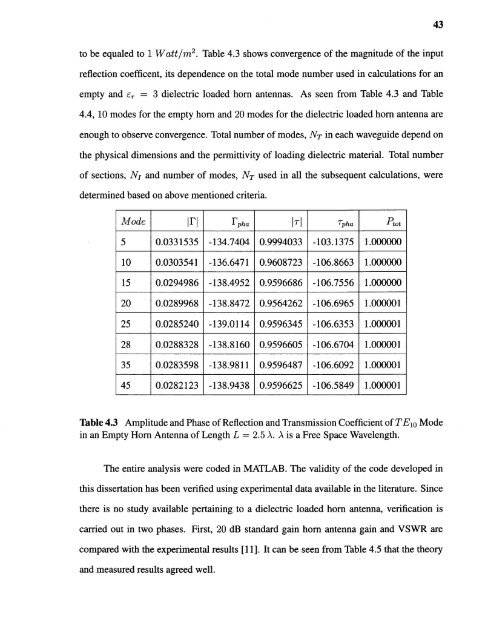Variable permittivity dielectric material loaded stepped-horn antenna
Variable permittivity dielectric material loaded stepped-horn antenna
Variable permittivity dielectric material loaded stepped-horn antenna
Create successful ePaper yourself
Turn your PDF publications into a flip-book with our unique Google optimized e-Paper software.
43to be equaled to 1 Watt/m². Table 4.3 shows convergence of the magnitude of the inputreflection coefficent, its dependence on the total mode number used in calculations for anempty and εr = 3 <strong>dielectric</strong> <strong>loaded</strong> <strong>horn</strong> <strong>antenna</strong>s. As seen from Table 4.3 and Table4.4, 10 modes for the empty <strong>horn</strong> and 20 modes for the <strong>dielectric</strong> <strong>loaded</strong> <strong>horn</strong> <strong>antenna</strong> areenough to observe convergence. Total number of modes, NT in each waveguide depend onthe physical dimensions and the <strong>permittivity</strong> of loading <strong>dielectric</strong> <strong>material</strong>. Total numberof sections, NI and number of modes, NT used in all the subsequent calculations, weredetermined based on above mentioned criteria.Table 4.3 Amplitude and Phase of Reflection and Transmission Coefficient of TE 10 Modein an Empty Horn Antenna of Length L = 2.5 A. A is a Free Space Wavelength.The entire analysis were coded in MATLAB. The validity of the code developed inthis dissertation has been verified using experimental data available in the literature. Sincethere is no study available pertaining to a <strong>dielectric</strong> <strong>loaded</strong> <strong>horn</strong> <strong>antenna</strong>, verification iscarried out in two phases. First, 20 dB standard gain <strong>horn</strong> <strong>antenna</strong> gain and VSWR arecompared with the experimental results [11] . It can be seen from Table 4.5 that the theoryand measured results agreed well.
















